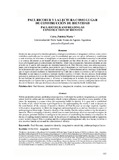| dc.rights.license | http://creativecommons.org/licenses/by-nc-sa/3.0/ve/ | |
| dc.contributor.author | Calvo, Patricia María | |
| dc.date.accessioned | 2016-09-28T13:17:27Z | |
| dc.date.available | 2016-09-28T13:17:27Z | |
| dc.date.issued | 2016 | |
| dc.identifier.issn | 1690-3226 | |
| dc.identifier.uri | http://www.saber.ula.ve/handle/123456789/42387 | |
| dc.description.abstract | Dentro de una perspectiva interdisciplinaria y dialógica estudiamos el imaginario estético, como esfera
simbólica construida por los artistas y por la comunidad, que a su vez ejerce influencia y condiciona a cada miembro de la misma; el imaginario es un espacio donde la comunidad construye su identidad y se conoce. El mismo es un mundo abierto e instaurado por las obras de arte, el cual se vuelve un locus privilegiado para el conocimiento del hombre. Dado este presupuesto, buscamos ahondar en este artículo en el aporte del concepto de identidad narrativa de Paul Ricoeur como una arista necesaria, junto con la imaginación creadora, para permitir que el imaginario se vuelva un locus antropológico y así la literatura un espacio de conocimiento antropológico. La identidad narrativa constituye la identidad
que el sujeto alcanza mediante la función narrativa. Cada uno se narra a sí mismo y allí se forja en su identidad, la cual nunca es estática y siempre implica recortes y olvidos. En este proceso, la identidad personal es análoga al proceso de constitución de la identidad de un personaje en una trama. En la acción
de leer habitan las transformaciones y el lector se transforma en la lectura. En el proceso de lectura, interpretación y re-figuración se gesta un mundo nuevo. Esta lectura y esta re-configuración no sólo se
da a nivel literario sino que involucra a la acción humana y la constitución de la identidad. | es_VE |
| dc.language.iso | es | es_VE |
| dc.rights | info:eu-repo/semantics/openAccess | |
| dc.subject | Paul Ricoeur | es_VE |
| dc.subject | Identidad narrativa | es_VE |
| dc.subject | Imaginación creadora | es_VE |
| dc.subject | Locus antropológico | es_VE |
| dc.title | Paul Ricoeur y la Lectura Como Lugar de Construcción de Identidad | es_VE |
| dc.title.alternative | Paul Ricoeur and Reading as Cconstructión of Identity | es_VE |
| dc.type | info:eu-repo/semantics/article | |
| dc.description.abstract1 | Within an interdisciplinary and dialogical perspective, I will study the aesthetic imagination, as a symbolic sphere built by artists and the community, which in turn influences and affects every member of the same; the imaginary is a space where the community builds its identity. It is open and is established by works of art, which become a privileged locus for understanding the world. I seek to deepen on the contribution of the concept of narrative identity of Paul Ricoeur as an edge required, together with creative imagination, to allow the imaginary anthropological locus and see literatures a space of anthropological knowledge. Narrative identity is the identity that the subject achieves by the narrative function. There is a forging of identity, which is never static and always involves cuts and oversights. In this process, personal identity is analogous to the process of establishing the identity of a character. In
the act of reading, transformations occur. In the process of reading, the interpretation and re-figuration
a new world is forged. This re-reading and this configuration happen not only in a literary level but it also involves human action and the constitution of identity. | es_VE |
| dc.description.colacion | 185-195 | es_VE |
| dc.description.email | pato.calvo@gmail.com | es_VE |
| dc.description.frecuencia | Semestral | |
| dc.identifier.eissn | 2244 - 842X | |
| dc.subject.facultad | Núcleo Rafael Rangel (NURR) | es_VE |
| dc.subject.institucion | Universidad de Los Andes | es_VE |
| dc.subject.keywords | Paul Ricoeur | es_VE |
| dc.subject.keywords | Narrative identity | es_VE |
| dc.subject.keywords | Imaginative creativity | es_VE |
| dc.subject.keywords | Anthropological locus | es_VE |
| dc.subject.pais | Venezuela | |
| dc.subject.publicacionelectronica | Academia | |
| dc.subject.thematiccategory | Artes y Humanidades | es_VE |
| dc.subject.tipo | Revistas | es_VE |
| dc.type.media | Texto | es_VE |


